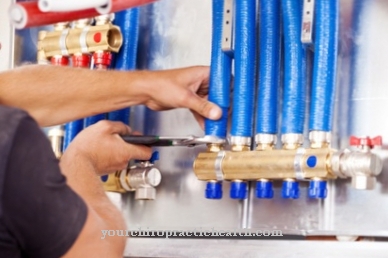Of the Urge to urinate corresponds to the conscious perception that the bladder has reached its maximum filling volume. Mechanoreceptors are located in the wall of the bladder, which register the pressure on the bladder as the level rises and pass the information on to the brain.
What is the urge to urinate?

The kidneys produce up to 1.5 liters of urine a day. The urinary bladder serves as a buffer for the urine produced in this way. The urine collects in the urinary bladder until it is emptied by micturition.
The capacity of the bladder is significantly less than the amount of urine the kidneys produce every day. When the urine in the urinary bladder has reached a volume of around 500 milliliters, the brain receives a notification via the nervous system and triggers the urge to urinate via pressure receptors in the bladder. When the human bladder is full, the human sensory cells feel a conscious need to urinate. This need arises from a control loop of the central and autonomous nervous system.
Control over urination is not innate; it is learned by children within the first five years of life. Before the control is gained, the bladder empties automatically with the urge to urinate and can thus again absorb the permanently produced urine of the kidneys.
Function & task
With normal fluid intake, the urinary bladder empties through the urethra up to six times a day. The amount of urine excreted averages around 400 milliliters for each micturition. Depending on your habit and fluid intake, this can vary up and down. The bladder has a maximum capacity which corresponds to the filling volume that triggers the imperative to urinate or leads to involuntary emptying of the bladder.
Different filling volume values apply to the urge to urinate between men and women. In men, the normal value is up to 600 milliliters of filling volume until the urge to urinate is noticeable. In women, the value is significantly lower, since their genital organs take up more space and the bladder therefore has a smaller volume. A woman's bladder holds around 400 milliliters without the need to urinate. These values can fluctuate to a greater or lesser extent from person to person. Confirmed maximum values do not exist.
The bladder receives its storage function from two sphincter muscles known as the outer striated and inner smooth sphincter. As the bladder becomes more and more full, the detrusor vesicae muscle has to adapt to the pressure conditions. If the muscle can no longer relax any longer and can no longer cope with the increasing pressure, the steep increase in pressure shifts into the interior of the bladder.
There are mechanoreceptors in the bladder that can sense stretching and pressure. In this way, the stretch receptors in the bladder wall trigger a micturition reflex. As a result, the urinary muscle contracts. The inner sphincter is passively stretched and the outer sphincter actively relaxes.
In a circuit of the autonomic nervous system, the information about the filling level of the bladder reaches the brain via the afferent nerves of the stretch receptors and in this way makes people aware of the urge to urinate. In the reticular formation, emptying of the bladder and the urge to urinate are controlled centrally. The parasympathetic nervous system initiates emptying of the bladder by allowing the bladder muscles to contract and thus supporting the emptying of the bladder. As its antagonist, the sympathetic nervous system relaxes the bladder after emptying the bladder, allowing it to be filled again. It stimulates the sphincter muscles to contract and thus prevents uninterrupted emptying of the bladder.
You can find your medication here
➔ Medicines for bladder and urinary tract healthIllnesses & ailments
As part of various diseases, patients often suffer from an increased urge to urinate.If the increased urge to urinate only occurs now and then, it is not yet a pathological phenomenon. Mostly an increase in fluid intake or the consumption of coffee, alcohol and other diuretic substances are responsible for this. The use of diuretics or psychological stress can also increase the urge to urinate.
A disease may only be present if there is an increased need to urinate for a long time. In this context, the urge to urinate can be described as a symptom of an illness and is not itself an illness.
An increased urge to urinate can occur symptomatically, for example in the context of diabetes mellitus and diabetes insipidus. Stage III of acute kidney failure is also characterized by an increased need to urinate. The same is true of hyposthenuria, polydipsia, and descensus uteri or prostatitis.
If an obese patient experiences an increased need to urinate, the phenomenon may be related to slackening of the pelvic floor muscles. Even new mothers often suffer from slack pelvic floor muscles and an increased urge to urinate immediately after giving birth.
If patients feel the urge to urinate, especially while sleeping or lying down, additional causes may be considered. For example, a cystitis or prostate hypertrophy in men can trigger the urge to urinate.
If there is an increased urge to urinate but not increased urine formation, other relationships must be considered. For example, a disease of the prostate or an irritable bladder can trigger this phenomenon. In women, this is the most likely cause in this regard however, an early stage of pregnancy.
In addition to an increased urge to urinate, the absence of the urge to urinate can also be a symptom of an illness. If the bladder empties without warning, there is incontinence, which may be due to malfunctions in the nervous system control circuits.













.jpg)

.jpg)
.jpg)











.jpg)